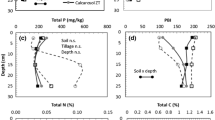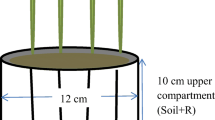Abstract
Nineteen soils from the south east of the Province of Buenos Aires (Argentina) that had been fertilized with moderate amounts of P (10–40 kgP/ha) during the last 10 years were used to investigate the effect of time on the decline of P availability as measured by three soil tests (Bray 1, Bray 2, Olsen) and the null-point method. Differences in rates of P decline among soils and chemical methods were characterized by an exponential coefficient for time (b 2) in equations which describe the changes of the added P retained by the soil (Pr =ac b1 t b2). The rate of decline of P for the nineteen soils calculated for the soil test methods was ordered decreasingly as: null-point > Olsen > Bray 1 > Bray 2. The ability of the chemical methods for assessing the residual value of P for wheat growth (RV) was tested in a pot experiment on seven of the soils that differed in their individual rates of reaction with P. Differences between soils in the rate of reaction with P as measured in the laboratory by the null-point method and by the Olsen test were reflected in different residual values for P fertilizer for wheat plants. Thus the value ofb 2 for these methods was well correlated with the observed residual values. The soil properties commonly associated with the retention of P were not related to the value ofb 2 suggesting that more than one soil property may be involved in the measure ofb 2. The exponent for timeb 2 may be used as an index of the ability of the soil test to reflect the decline of P availability with time.
Similar content being viewed by others
References
Agboola A and Ayodele OJ (1983) An attempt to evaluate plant available P in Western Nigeria Savannah soils under traditional fallow systems. Third International Congress on Phosphorus Compounds Proceedings. Imphos. Brussels. Belgium. 261–87
Barrow NJ (1974) The slow reaction between soil and anions: 1. Effects of time, temperature and water content of a soil on the decrease in effectiveness of phosphate for plant growth. Soil Sci 118: 380–86
Barrow NJ (1980a) Differences amongst a wide-ranging collection of soils in the rate of reaction with phosphate. Aust J Soil Res 18: 215–24
Barrow NJ (1980b) Evaluation and utilization of residual phosphate in soils In ‘The role of phosphorus in agriculture’ (Ed FE Khasawneh, EC Sample and EJ Kamprath) American Society of Agronomy, Madison Wisconsin
Barrow NJ (1980c) Differences among some north american soils in the rate of reaction with phosphate. J Environ Qual 9: 644–48
Barrow NJ (1983a) A discussion of methods for measuring the rate of reaction between soil and phosphate. Fert Res 4: 51–61
Barrow NJ (1987) The reaction of anions and cations with soil In ‘Reactions with variable-charge soils’ (Martinus Nijhoff Publishers) Dordrecht, The Netherlands
Barrow NJ and Campbell NA (1972) Methods of measuring the residual value of fertilizers. Aust J Exp Agric Anim Husb 12: 502–10
Barrow NJ and Shaw TC (1976a) Sodium bicarbonate as an extractant for soil phosphate. 1 Separation of the factors affecting the amount of phosphate displaced from soil from those affecting secondary adsorption. Geoderma 16: 91:107
Barrow NJ and Shaw TC (1976b) Sodium bicarbonate as an extractant for soil phosphate. 2 Effects of varying the condition of extraction on the amount of phosphate initially displaced and on the secondary adsorption
Barrow NJ and Shaw TC (1976c) Sodium bicarbonate as an extractant for soil phosphate. 3 Effects of buffering capacity of a soil for phosphate. Geoderma 16: 273–82
Black CA and Scott CO (1956) Fertilizer evaluation. 1 Fundamental principles. Soil Sci Soc Am Proc 20: 176:79
Blakemore LC, Searly PL and Daly BK (1981) Methods for chemical analyses of soils N Z Soil Bur Sci Rep 10 A. Soil Bureau, lower Hutt New Zealand
Bray RH and Kurtz LT (1945) Determination of total. organic and available forms of phosphorus in soils. Soil Sci 59: 39–45
Fitter AM (1974) A relationship between phosphorus requirements, the immobilization of added phosphate, and the phosphate buffering capacity of colliery shales. J Soil Sci 25: 41–50
Holford ICR (1980) Greenhouse evaluation of four phosphorus soil tests in relation to phosphate buffering and labile phosphate in solids. Soil Sci Soc Am J 44: 555–59
Kuo S, Jellum EJ and Pan WL (1988) Influence of phosphate sorption parameters of soils on desorption of phosphate by various extractants. Soil Sci Soc Am J 53: 974–79
Mehara OP and Jackson ML (1960) Iron oxide removal for soils and clays by a dithionite-citrate system buffered with sodium bicarbonate. Clays and Clay Min 7th Conference 317–27
Mendoza RE (1989a) Ritmo de la reacción entre el fósforo y el suelo y su relación con el valor residual del fósforo aplicado para el crecimiento de trébol. Ciencia del Suelo 7: 21–9
Mendoza RE (1989b) Different performances of soil phosphate tests for reflecting the effects of buffering capacity on uptake of native phosphate with time. Plant Soil 113: 13–9
Mendoza RE and Menalled F (1988) Efecto de la reacción entre el fósforo y cuatro suelos sobre la producción y el fósforo extractable. Ciencia del Suelo 6: 50–5
Mendoza RE and Barrow NJ (1987a) Ability of three soil extractants to reflect the factors that determine the availability of soil phosphate. Soil Sci 144: 319–29
Mendoza RE and Barrow NJ (1987b) Characterizing the rate of reaction of some argentinean soils and phosphate. Soil Sci 143: 105–12
Mendoza RE, Canduci A and Aprile C (1990) Phosphate release from fertilized soils and its effect on the changes of phosphate concentration in soil solution. Fert Res 23: 165–72
Olsen SR, Cole CV, Watanabe FS and Dean LA (1954) Estimation of available phosphorus in soils by extraction with sodium bicarbonate. USDA Circ. 939
Peck TR, Kurtz LT and Tandon HLS (1971) Changes in Bray P-1 soil phosphorus test values resulting from application of phosphorus fertilizer to winter wheat. Soil Sci Soc Am J 35: 595–98
Sharply AN (1987) Relative availabilities of native, residual and fertilizer phosphorus to winter wheat. Soil Sci Soc Am J 51: 1531–35
Sims FW and Ellis BG (1983) Adsorption and availability of phosphorus following the application of limestone to an acid aluminous soil. Soil Sci Soc Am J 47: 888–93
Yerokun OA and Christenson DR (1990) Relating high soil test phosphorus concentrations to plant phosphorus uptake. Soil Sci Soc Am J 54: 796–799
Author information
Authors and Affiliations
Rights and permissions
About this article
Cite this article
Mendoza, R.E. Phosphorus effectiveness in fertilized soils evaluated by chemical solutions and residual value for wheat growth. Fertilizer Research 32, 185–194 (1992). https://doi.org/10.1007/BF01048781
Received:
Accepted:
Issue Date:
DOI: https://doi.org/10.1007/BF01048781




